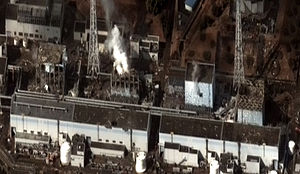रेडियोएक्टिव प्रदूषण
रेडियोएक्टिव प्रदूषण (Radioactive contamination) चाहे रेडियोधर्मी प्रदूषण (radiological contamination) अइसन स्थिति हवे जब कौनों इलाका में सतह पर, ठोस पदार्थ सभ में, द्रव सभ में चाहे गैसे में रेडियोएक्टिव पदार्थ के जमाव (डिपोजीशन) होखे चाहे मौजूदगी होखे, (इहाँ तक के मनुष्य के शरीर में अइसन मौजूदगी हो सके ला) आ ई मौजूदगी अनचाहल होखे आ जान के ना होखे।

रेडियोएक्टिव पदार्थ सभ के मौजूदगी से दिक्कत ई होला कि इनहन के क्षय होला आ एह प्रक्रिया में इनहन से खतरनाक रेडियेशन निकले ला। अइसन रेडियेशन में आयोनाइजिंग रेशियेशन जइसे कि अल्फ़ा अ बीटा एडियेशन, गामा किरण, आ न्यूट्रान हो सके लें।
संदर्भ
संपादन करीं- ↑ Richard Schiffman (12 मार्च 2013). "Two years on, America hasn't learned lessons of Fukushima nuclear disaster". The Guardian.
- ↑ Martin Fackler (जून 1, 2011). "Report Finds Japan Underestimated Tsunami Danger". New York Times.
| ई पर्यावरण-संबंधी लेख एगो आधार बाटे। जानकारी जोड़ के एकरा के बढ़ावे में विकिपीडिया के मदद करीं। |